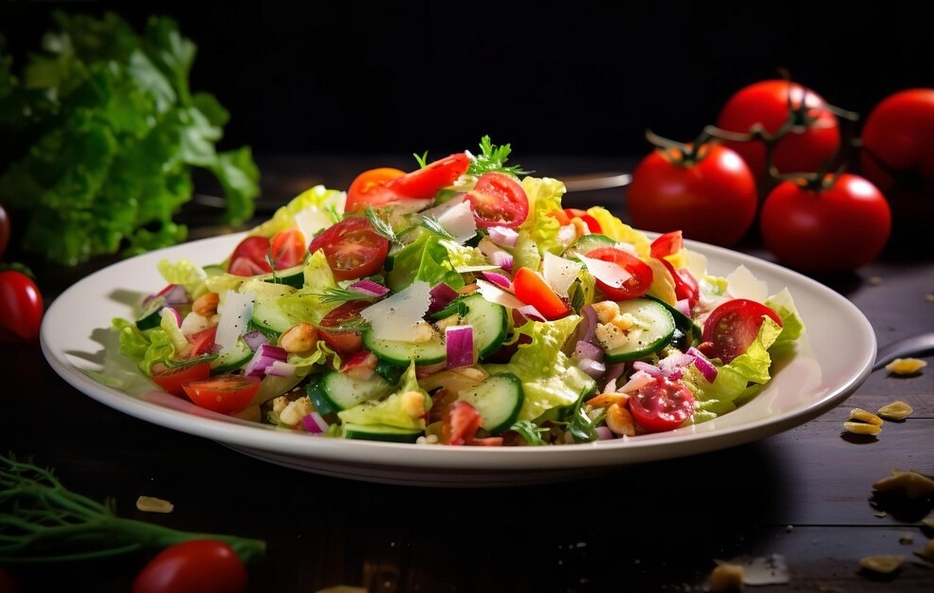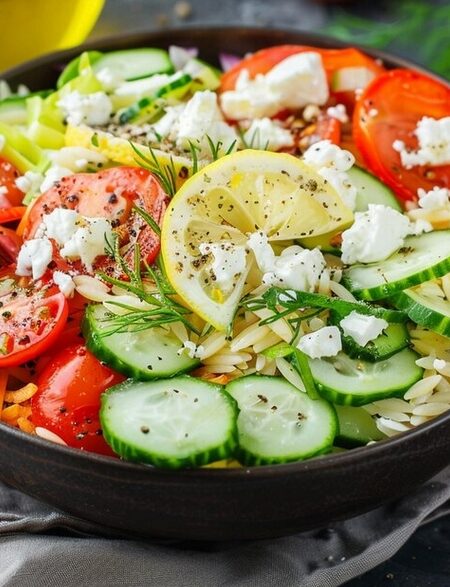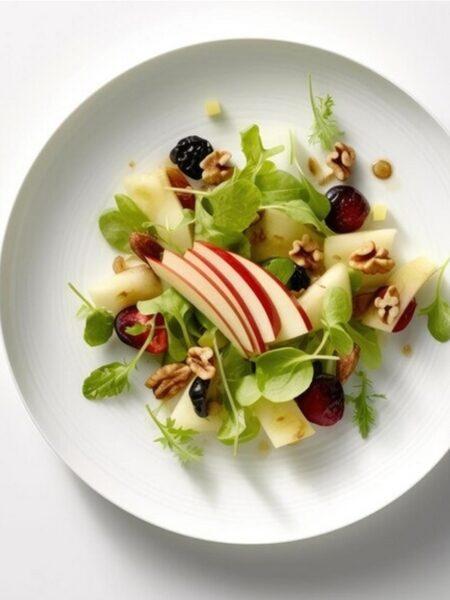Italian Chopped Salad Recipe
Italian Chopped Salad: A Symphony of Freshness and Bold Italian Flavors. In the world of salads, few dishes strike a perfect balance between convenience, nutrition, and full-bodied flavor like the Italian Chopped Salad. It’s a colorful mosaic of crisp greens, savory meats, creamy cheeses, tangy peppers, juicy tomatoes, and briny olives—all harmonized by a zesty vinaigrette that brings the ensemble to life. More than just a bowl of vegetables, the Italian Chopped Salad is a culinary celebration—an edible testament to the versatility and warmth of Italian and Italian-American kitchens.
Though “chopped salad” may seem like a modern invention tailored to today’s fast-paced lifestyles, its roots stretch back through generations of home cooks and restaurant chefs who understood the beauty of a well-balanced bite. When that concept met the bold flavors of traditional Italian ingredients, the result was an instant classic. Whether served as a side, main, or shareable dish at gatherings, this salad has firmly earned its place as a timeless favorite.
A Brief History of Chopped Salads
The chopped salad concept gained popularity in the United States during the mid-20th century, especially in fine dining restaurants where patrons preferred salads that could be eaten gracefully with a fork—no long leafy strands to wrestle with, no oversized bites to contend with. Instead, everything was cut to uniform size, allowing each forkful to deliver a complete flavor experience.
One of the most iconic examples of this trend is the La Scala chopped salad, developed in Beverly Hills in the 1950s. It featured finely diced lettuce, salami, cheese, and garbanzo beans tossed in a tangy dressing—simple, elegant, and immensely satisfying. From that origin point, chopped salads began appearing in menus everywhere, each reflecting regional and cultural influences. The Italian Chopped Salad, with its Mediterranean heart and bold, vibrant ingredients, became one of the most beloved variations.
What Makes It Distinctively Italian- Italian Chopped Salad
The Italian Chopped Salad isn’t just a salad with Italian ingredients—it’s a bold celebration of what makes Italian cuisine so universally adored: balance, color, and flavor. It brings together salty, sweet, sour, and savory elements into a single, cohesive dish. Think cured meats like salami or pepperoni paired with creamy provolone or mozzarella, married to crisp romaine lettuce, fresh tomatoes, and crunchy cucumbers.
Add to that the punch of pepperoncini, the umami of olives, and the earthiness of chickpeas, and you get a salad that’s far more than the sum of its parts. What sets it apart further is the dressing—a red wine vinaigrette infused with oregano, garlic, and Dijon mustard. It’s bold enough to complement the hearty ingredients, yet balanced enough to let the freshness shine.
Flavor Profile: A Bite of Everything, Every Time
What truly defines a chopped salad is that every bite includes a bit of everything. By cutting the ingredients into similar sizes, you allow the textures and flavors to intermingle. In one forkful, you might get the crispness of lettuce, the richness of salami, the creaminess of cheese, and the tangy burst of vinaigrette all at once.
This symmetry creates a dining experience that’s as satisfying as it is dynamic. There are no dull bites—just layers of taste and texture that keep you coming back for more. Unlike tossed salads, where heavier ingredients often sink to the bottom, chopped salads ensure consistency from the first bite to the last.
Nutrition with Substance and Satisfaction
One of the reasons Italian Chopped Salad has earned its reputation as a full meal rather than just a side is its nutritional composition. With a mix of leafy greens, raw vegetables, protein-rich legumes, and healthy fats from olives and olive oil, it’s a balanced meal in itself. The optional additions of salami and cheese lend richness and additional protein, making the salad both filling and flavorful.
For those focused on health and wellness, it offers a customizable template: go heavier on the greens and chickpeas for a plant-forward dish, or add grilled chicken for a lean protein boost. Gluten-free by default and easy to make vegetarian or even vegan, the Italian Chopped Salad is adaptable without sacrificing taste.
Perfect for Any Occasion- Italian Chopped Salad
The Italian Chopped Salad is remarkably versatile. It fits into lunch boxes, picnic baskets, potluck tables, and dinner party menus with equal ease. It’s sophisticated enough to impress guests but simple enough for a weeknight dinner. Because it holds up well even after being dressed—thanks to its sturdy ingredients—it’s also great for meal prep.
When paired with crusty bread or a bowl of soup, it becomes a complete meal. Served on its own, it’s refreshing and satisfying. And as a side to pizza or pasta, it balances richness with brightness, cleansing the palate and adding contrast.
Regional and Personal Variations
Like many dishes in Italian cuisine, the chopped salad welcomes improvisation. Depending on what’s in your fridge or what’s fresh at the market, the salad can take on different personalities. Some prefer it with artichoke hearts or roasted red peppers. Others might throw in diced avocado for creaminess, or swap out pepperoncini for banana peppers.
Even the meats and cheeses can rotate—prosciutto, mortadella, Parmesan, or even feta can find their way into different versions. The key is maintaining the balance of flavors: something crisp, something savory, something creamy, something acidic.
A Modern Classic with Roots in Tradition- Italian Chopped Salad
The Italian Chopped Salad is a wonderful example of culinary evolution. It marries old-world Italian flavors with new-world dining preferences. It’s clean, satisfying, and endlessly customizable. It respects tradition but doesn’t shy away from innovation.
In a time when people are looking for meals that are fast yet flavorful, healthy yet hearty, this salad delivers on all fronts. It encourages home cooks to explore, to mix, to chop, and to experiment—all while delivering consistently delicious results.
Italian Chopped Salad – More Than Just a Salad
At first glance, the Italian Chopped Salad may look like just another mix of greens and toppings. But dig in, and you’ll find a dish that’s rich in heritage, full of personality, and capable of standing proudly among the world’s most beloved salads. It’s a bowl of contrasts—light yet filling, rustic yet refined, familiar yet endlessly new.
Whether you’re a fan of Italian cuisine, a busy home cook, or someone simply looking for a better lunch option, the Italian Chopped Salad is a dish that checks all the boxes. It’s a salad with soul—and that’s what makes it unforgettable.
A colorful, crunchy, and zesty salad bursting with classic Italian flavors—perfect as a main course or a hearty side.
Italian Chopped Salad Recipe
Ingredients:
For the Salad:
- 1 head Romaine lettuce, chopped
- 1 cup radicchio or red cabbage, chopped
- 1 cup cherry tomatoes, halved
- 1/2 cup cucumber, sliced
- 1/2 cup pepperoncini, sliced
- 1/4 cup red onion, thinly sliced
- 1/2 cup salami or pepperoni, chopped
- 1/2 cup provolone cheese, diced
- 1/4 cup black or Kalamata olives, sliced
- 1/4 cup canned chickpeas (garbanzo beans), rinsed and drained
- Freshly grated Parmesan (optional, for topping)
For the Dressing:
- 1/4 cup extra virgin olive oil
- 2 tablespoons red wine vinegar
- 1 teaspoon Dijon mustard
- 1 garlic clove, minced
- 1/2 teaspoon dried oregano
- Salt and black pepper to taste
- Pinch of sugar (optional)
Cooking Instructions:
- Make the dressing: In a small bowl or jar, whisk together olive oil, vinegar, mustard, garlic, oregano, salt, pepper, and sugar. Set aside.
- Prepare the salad base: In a large salad bowl, combine chopped Romaine, radicchio, tomatoes, cucumber, pepperoncini, red onion, olives, and chickpeas.
- Add protein and cheese: Toss in chopped salami (or pepperoni) and provolone.
- Dress the salad: Pour the dressing over the salad just before serving and toss well to combine.
- Serve: Garnish with freshly grated Parmesan if desired. Serve immediately for best texture.
Total Time Breakdown:
- Prep Time: 15 minutes
- Cook Time: 0 minutes
- Total Time: 15 minutes
Servings:
- Makes 4 servings as a main dish
- 6–8 servings as a side
Essential cooking tips – Italian Chopped Salad
1. Use Fresh, Crisp, and Dry Greens
The backbone of any chopped salad is the greens, and in an Italian Chopped Salad, crispness is non-negotiable. Romaine lettuce and radicchio are common base greens for this dish because they are both crunchy and sturdy. However, no matter which greens you choose, they must be fresh and thoroughly dried after washing. Wet leaves dilute the dressing and make the salad soggy, especially if you’re prepping ahead of time. A salad spinner is highly recommended to remove excess moisture. Dry greens not only preserve texture but also allow the vinaigrette to cling better, resulting in a more flavorful salad.
2. Cut Ingredients Uniformly for Balanced Bites
One defining feature of chopped salad is that every forkful delivers a little bit of everything. To achieve this, make sure all your ingredients are chopped to a uniform, bite-sized dimension. Whether it’s the cucumbers, salami, cheese, or olives, consistency in size is crucial. This not only enhances the eating experience but also ensures even distribution of textures and flavors. Uniform cuts also contribute to an attractive presentation, especially when serving to guests or at events.
3. Layer Bold Flavors but Don’t Overload
The appeal of an Italian Chopped Salad lies in its dynamic flavor profile—salty meats, briny olives, spicy pepperoncini, and rich cheeses all coexist in harmony. However, it’s easy to go overboard. Be mindful not to include too many competing elements, as it can overwhelm the palate and mask the freshness of the vegetables. Stick with 2–3 strong flavor accents (like salami, provolone, and olives), and complement them with neutral, crunchy vegetables such as cucumbers or chickpeas. Less is often more when the goal is flavor balance.
4. Use a Bold, Well-Emulsified Vinaigrette
The dressing is the thread that ties all the ingredients together. An Italian-style vinaigrette, typically made with olive oil, red wine vinegar, Dijon mustard, garlic, oregano, salt, and pepper, should be tangy and robust enough to stand up to hearty ingredients like cheese and cured meats. Make sure to whisk or shake the dressing thoroughly so it emulsifies—meaning the oil and vinegar combine into a cohesive mixture. This prevents oily separation and ensures that every bite is evenly coated. You can also prepare the dressing a few hours ahead of time to let the flavors meld for a more impactful punch.
5. Dress Just Before Serving to Maintain Texture
For best results, always dress the salad right before serving. While Italian Chopped Salad holds up better than most leafy salads due to its sturdy ingredients, pre-dressing can still lead to wilting or sogginess, especially if it sits too long. If you’re meal-prepping or bringing it to a gathering, pack the dressing separately and mix it in at the last minute. If you want the salad to absorb the vinaigrette flavor slightly (especially when using chickpeas), you can dress it 10–15 minutes ahead, but toss it gently and monitor the texture.
FAQs for the Italian Chopped Salad recipe
1. Can I make Italian Chopped Salad in advance?
Yes, you can prep the ingredients for Italian Chopped Salad in advance, but it’s best to keep them separate from the dressing until just before serving. Chop your greens, vegetables, meats, and cheese, and store them in airtight containers in the refrigerator. The dressing can be made ahead and stored in a sealed jar. When you’re ready to eat, simply toss everything together. This prevents the salad from becoming soggy and maintains the crisp texture that’s essential to a great chopped salad.
2. What kind of lettuce is best for Italian Chopped Salad?
Romaine lettuce is the most commonly used green for Italian Chopped Salad due to its sturdy, crisp texture and neutral flavor. It holds up well against heavier toppings like salami, cheese, and chickpeas. Radicchio or red cabbage can be added for color and a slightly bitter contrast. Avoid soft lettuces like butter or spring mix, as they tend to wilt quickly and can’t support the weight or intensity of the salad’s other ingredients.
3. Can I make this Italian Chopped Salad vegetarian or vegan?
Absolutely. To make a vegetarian Italian Chopped Salad, simply omit the meat (like salami or pepperoni) and consider adding protein-rich chickpeas, cannellini beans, or marinated tofu for substance. To make it vegan, in addition to removing the meat, swap out dairy-based cheeses for vegan alternatives, and ensure your dressing is made without honey or Parmesan. The result is still flavorful and satisfying without animal products.
4. What’s the best cheese to use in this recipe of Italian Chopped Salad?
Provolone and mozzarella are popular choices because they offer mild, creamy flavor and pair well with the salad’s bold ingredients. Parmesan adds a sharp, salty kick and can be shaved over the top as a finishing touch. You can experiment with fontina, Asiago, or even feta if you’re looking to add a bit of tang or richness. The cheese should complement the other components without overwhelming the overall flavor profile.
5. What dressing works best for Italian Chopped Salad?
A classic red wine vinaigrette is traditional and pairs beautifully with the ingredients in Italian Chopped Salad. It typically includes olive oil, red wine vinegar, Dijon mustard, oregano, garlic, salt, and pepper. Some versions add a touch of sugar or honey to balance the acidity. The key is making sure the dressing is tangy and bold enough to stand up to cured meats, cheeses, and olives, yet light enough to preserve the freshness of the vegetables.
6. Can I substitute the meat with something else in this Italian Chopped Salad recipe?
Yes, you can easily substitute or skip the meat altogether. Grilled chicken, turkey breast, roasted chickpeas, or tofu are excellent alternatives for those avoiding processed meats. If you still want that salty-savory component but want to reduce fat, consider using leaner options like turkey pepperoni. Plant-based deli slices can also mimic the flavor and texture of traditional Italian meats for vegetarian or vegan adaptations.
7. How long will leftovers last in the fridge?
Once dressed, Italian Chopped Salad is best eaten the same day, as the dressing will cause the greens to wilt over time. However, if stored properly in an airtight container, undressed leftovers can last for up to 2–3 days. Ingredients like salami, cheese, olives, and chickpeas will keep well, but fresh greens should be added at the last minute for the best texture and appearance.
8. Is Italian Chopped Salad gluten-free?
Yes, this salad is naturally gluten-free as it contains no pasta or bread. However, you should always double-check ingredient labels—especially for processed items like salami, dressings, or cheese—to ensure they are certified gluten-free. Gluten-free croutons or crispy chickpeas can be added for crunch without compromising dietary needs.
9. Can I add pasta to this Italian Chopped Salad recipe?
Absolutely. While it won’t be a traditional chopped salad anymore, adding pasta (like rotini, penne, or bowtie) turns this into an Italian pasta salad hybrid that’s heartier and ideal for potlucks or picnics. Make sure the pasta is cooked al dente and cooled completely before mixing it in to maintain the salad’s refreshing texture.
10. What are some good side dishes to serve with Italian Chopped Salad?
Italian Chopped Salad pairs beautifully with a variety of dishes. For a light lunch, it can be served with garlic bread, a slice of focaccia, or a small bowl of soup like minestrone or tomato basil. As a dinner side, it complements pasta dishes, grilled chicken, lasagna, or pizza. Its vibrant flavor and crisp texture make it a great contrast to richer, carb-heavy entrées.
Italian Chopped Salad Recipe
At first glance, the Italian Chopped Salad may look like just another mix of greens and toppings. But dig in, and you'll find a dish that’s rich in heritage, full of personality, and capable of standing proudly among the world’s most beloved salads. It’s a bowl of contrasts—light yet filling, rustic yet refined, familiar yet endlessly new.

Ingredients
For the Salad:
For the Dressing:
Instructions
• Make the dressing:
- In a small bowl or jar, whisk together olive oil, vinegar, mustard, garlic, oregano, salt, pepper, and sugar. Set aside.
• Prepare the salad base:
- In a large salad bowl, combine chopped Romaine, radicchio, tomatoes, cucumber, pepperoncini, red onion, olives, and chickpeas.
• Add protein and cheese:
- Toss in chopped salami (or pepperoni) and provolone.
• Dress the salad:
- Pour the dressing over the salad just before serving and toss well to combine.
• Serve:
- Garnish with freshly grated Parmesan if desired. Serve immediately for best texture.





